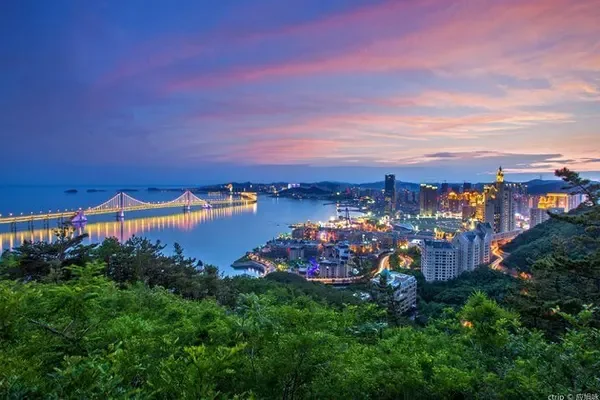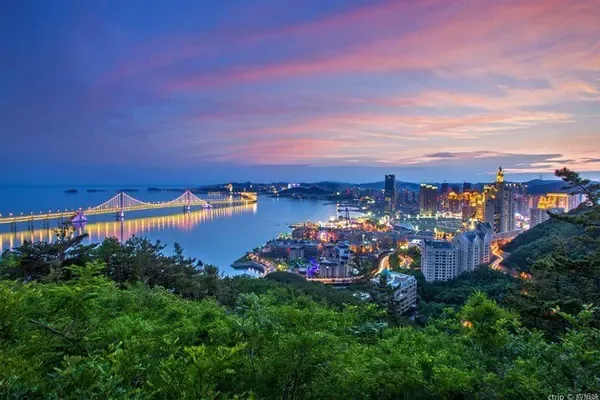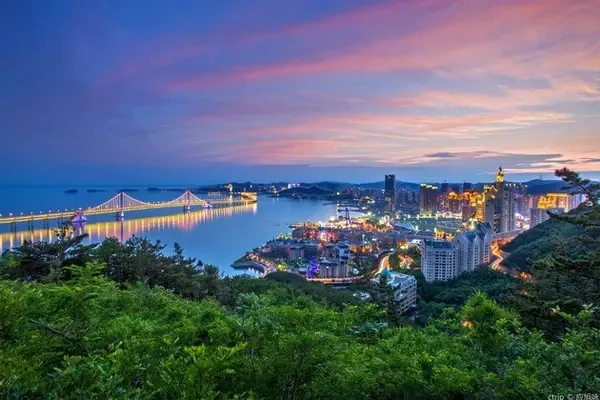In March 2021, on the occasion of celebrating the 100th anniversary of the founding of the party and carrying out the study and education of party history throughout the party, we came to Zunyi City, Guizhou Province, which had a significant turning point in the party's history. At the same time, he appreciated the magnificent rivers and mountains of the great motherland.

Zunyi City is located in the northern part of Guizhou Province. It is the city with the largest area and the largest registered population in the province. It has a national civilized city, a national historical and cultural city, a national forest city, a national sanitation city, a national garden city, and an excellent tourist city in China. title. What this important town in northern Guizhou is most proud of is that the Red Army of Chinese Workers and Peasants held the Zunyi Conference here in January 1935. At a critical moment, the revolution was saved and the course was reversed.


Zunyi has a long history and was successively called Itching State, Lang State, and Bozhou. It was renamed Zunyi County in the 16th year of Tang Zhenguan (AD 642). Obey the righteousness of the king." It means that the politicians should deal with things justly and follow the laws of heaven to rule the world. Due to geographical location and terrain conditions, the development level here has always been low. However, in recent years, it has been synchronized with the leapfrog development of Guizhou Province, and its economy has grown rapidly. It ranks firmly as the second largest city in Guizhou and the fifth largest city in Southwest China in terms of economic aggregate.


This time I stayed in Zunyi for 3 days and Guiyang for 2 days, plus I have been to Huangguoshu, Libo Zhangjiang, Xijiang Miao Village, Fanjing Mountain and other places before. I feel that the colorful Guizhou is picturesque and the tourism service is top-notch. In March, when the spring breeze is blowing, the eyes are full of green, the mountain flowers are in full bloom, the streets are clean, and the air quality is good. The residents are also very enthusiastic. When asking for directions, no one seemed impatient. The tour guides, drivers, and waiters are very helpful, which is much better than the neighbors who are often exposed to fool you and force consumption.



Schedule for this trip:
Day 1: Zunyi Conference Memorial Hall, Red Army Mountain, Xiangjiang River, Laosha Lane, Swan Lake Park
Day 2: Gouba Meeting Site, Huamao Village, Fengxiang Town, Maotai Ferry, Red Army Long March Crossing Maotai Exhibition Hall, Sidu Chishui Memorial Tower, Chishui River, 1915 Square
Day 3: Loushanguan marching training, pot-burying and cooking experience, Loushanguan battle site, exhibition hall
Day 4: Xifeng Concentration Camp Revolutionary History Memorial Hall, China Yangming Cultural Park
Day 5: Guizhou Provincial Museum, Zhucheng Square, Nanming River, Jiaxiu Tower, Huaguoyuan "White House", "Twin Towers"



【Zunyi Meeting Memorial Hall】

The Zunyi Conference Memorial Hall consists of a series of buildings, including the site of the Zunyi Conference, the exhibition hall of the Zunyi Conference, the former site of the General Political Department of the Red Army, the former site of the Red Army Garrison Command, the former site of the National Bank of the Republic of China, and the residence of Mao Zedong, Zhang Wentian, and Wang Jiaxiang during the Zunyi Conference. Deng Xiaoping's residence, Li Debo's ancient residence, the Red Army cadre meeting venue, and the Zunyi Red Army Martyrs Cemetery cover a total area of more than 40,000 square meters, with a construction area of 18,000 square meters and an exhibition room area of more than 6,000 square meters.

Everyone knows about the Zunyi Conference. Here are three important points: (1) The Zunyi meeting was held during the Long March from January 15 to 17, 1935, at No. 96 Pipa Bridge (now Ziyin Road) in Zunyi City, Bai Hui, the former commander of the Second Division of the 25th Army of the Kuomintang It was held on the second floor of Zhang's private residence, and the main topic was to summarize the experience and lessons learned from the fifth counter-campaign against "encirclement and suppression". (2) The spirit of the Zunyi Conference is "firm belief, seeking truth from facts, independence, daring to break new ground, and democratic unity", which is the result of a series of important meetings before and after. The later Tashi Conference, Gouba Conference, and Huili Conference provided guarantees for the implementation of the Zunyi Conference. (3) A series of important meetings established and consolidated Comrade Mao Zedong's leading position in the Party Central Committee and the Red Army, and opened a new stage for the Party to independently solve the practical problems of the Chinese revolution.

The six characters of "Zunyi Conference Site" were inscribed by Comrade Mao Zedong in November 1964. This is the only inscription of the old man for the national revolutionary memorial site.

The focus of the tour is to visit the Zunyi Conference site and exhibition hall. The process is, first go to the site of the Zunyi Conference, listen to the explanation on the first floor, and look at the exterior of the building (the conference room is on the second floor, which is protected as a cultural relic and is generally not open to the public), and then visit the Zunyi Conference Exhibition Hall.





The two sides of the archway are written with "Shen Du" and "Wei Lu" respectively.


Residence of Peng Dehuai and Yang Shangkun


Pretend to visit the conference room on the second floor

The Zunyi Conference Exhibition Hall takes the Long March as the main line, and through the five themes of "Strategic Transfer, Start the Long March", "Zunyi Conference, Great Turning Point", "Move to Guizhou, Surprise Victory", "Move Forward to Victory", and "Zunyi Conference, Glory Eternal", highlight the Zunyi Conference historical meaning.






The Zunyi Conference made four decisions: (1) Comrade Mao Zedong was elected as a member of the Standing Committee. (2) Designate Comrade Luo Fu to draft the resolution, entrust the Standing Committee to review it, and send it to the branch for discussion. (3) Appropriate division of labor among the Standing Committee. (4) The three-member regiment was abolished, and the top military chiefs Zhu and Zhou were still the military commanders, while Comrade Enlai was entrusted by the party to be responsible for the final decision to command the military.

Photocopy of Chen Yun's manuscript recording the four decisions of the Zunyi Conference.


The telescope used by Zhou Enlai during the Long March

The revolver used by Nie Rongzhen during the Long March

The dagger used by Li De during the Long March

The lithography machine used by the Red Army to print propaganda materials in Zunyi

Bullets and magazines left by the White Army when crossing Chishui




A group photo of some ethnic minority fighters participating in the Red Army after arriving in northern Shaanxi during the Long March



In June 1945, Mao Zedong pointed out in his speech "On the Election of Alternate Members of the Seventh Central Committee" that "the Zunyi Conference is a key point and has a great influence on the Chinese revolution."

"Chen Yun and Zunyi Conference" showroom

Former Site of the General Political Department of the Red Army

According to research, the term "Long March" was first used by Commander-in-Chief Zhu De. In October 1934, when the Central Red Army set off from Ruijin, it did not use the term "Long March", but used "breakthrough", "transfer" and "Western Expedition" in stages; before breaking through the four blockade lines, the Red Army literature generally "Breakthrough" and "transfer" are used; from November 1934 to April 1935, the Central Red Army has been advancing westward, and "Western Expedition" is used during this period. In May 1935, the term "Red Army's Long March" was used for the first time in the "Chinese Workers' and Peasants' Red Army Announcement" issued by the Central Committee of the Communist Party of China in the name of Zhu De, commander-in-chief of the Red Army. The notice has a total of 156 characters, and it is written in the form of rhyme, "...the Red Army's long march, the direction is like a broken bamboo; now it has come to western Sichuan, respecting the customs of the barbarians...." The signature is "Red Army Commander-in-Chief Zhu De". This is the earliest written record of the word "Long March" found so far.


Sculpture "Turning the Tide"

【Red Army Mountain】

Hongjun Mountain, formerly known as "Xiaolong Mountain", is located at the foot of Fenghuang Mountain and on the banks of the Xiangjiang River, 1 km away from the Zunyi Conference site.

Up the 280 steps is the Red Army Martyrs Monument built in 1984 to commemorate the 50th anniversary of the Zunyi Conference.

The monument is 35 meters high, symbolizing the convening of the Zunyi Conference in 1935; the monument is engraved with the eight characters "Red Army Martyrs Are Immortal" inscribed by Deng Xiaoping in November 1984; the exterior of the monument is supported by a large circle with four heads representing the old people. Red Army, Young Red Army, Red Guards and Female Red Army, there are 28 stars outside the circle, implying the Communist Party of China's 28-year history of seizing power from 1921 to 1949 and the Zunyi Conference will always shine.


The circular relief depicts the scene of the Red Army attacking Zunyi and crossing Chishui four times.

A statue of a Red Army health worker feeding medicine to the dry man's son. Before liberation, the poor in Guizhou were called "ganren", which means they were squeezed out.

A group of soldiers are exercising

By the way, attractions such as the Zunyi Conference Memorial Hall are located in the old town of Zunyi. To visit, you need to transfer to a special bus at the tourist distribution center.

【Xiangjiang River】

The Xiangjiang River, also known as the Xiangjiang River, is a tributary of the Wujiang River in the Yangtze River system. The main stream originates from Maoshi Town, Huichuan District, Zunyi City, with a total length of 155 kilometers. It flows through Huichuan District, Honghuagang District, Xinpu New District, Suiyang County, Meitan County, Tongzi County, Fenggang County, The 8 counties (districts) in Bozhou District are the main water sources for local production and life, hydropower development and utilization, and are called the mother river.


The water quality is very clear and the environment is very beautiful. Although it is not a holiday, there are still many residents hanging out, walking and fishing by the river.

There is also a Xiangjiang River in Hunan. In November 1934, at the beginning of the Long March, the Red Army suffered heavy losses in the Battle of Xiangjiang River. In just 2 months, history has changed. After the Red Army conquered Zunyi for the first time in January 1935, one day Mao Zedong asked the people around him, "Are there many people from Hunan who came to Zunyi to do business?" He replied, "The river that flows through Zunyi is called the Xiangjiang River." Mao Zedong heard this. Startled, "Why, the river in Zunyi is also called the Xiangjiang River?" This connects the Xiangjiang River in Hunan, the birthplace of Mao Zedong, with the Xiangjiang River in Zunyi, the place where Mao Zedong rose.

Long March Poetry Wall


The bridges on the Xiangjiang River are unique

Shilong Bridge, the first stone arch bridge newly built by the government after liberation, was called Memorial Bridge when it was completed in 1956, and was renamed Shilong Bridge in 1982.


flap dam


Kezhen Bridge is covered with green plants throughout the year. This is to commemorate the outstanding contribution of Zhu Kezhen, the former president of Zhejiang University, to the cultural and educational cause of Zunyi and even the entire Guizhou. The bridge was specially named when it was built in 2002. During the Anti-Japanese War, Zhejiang University moved westward to Zunyi, and the School of Liberal Arts, School of Engineering, Institute of History and Geography, and dormitories for teachers and students of the school headquarters were distributed on both sides of the Xiangjiang River.

Xinhua Bridge was first built in the Ming Dynasty. It was originally a flat stone bridge. During the Kangxi period of the Qing Dynasty, a Jiangsu monk named Zhaoche raised funds to rebuild it. It was named Wu Bridge, also known as Wanshou Bridge. After liberation, it was renamed Xinhua Bridge.


Tianxiu Bridge, built in 1986, is a double-layer pedestrian-vehicle diversion overpass with reinforced concrete structure.


Lion Bridge, formerly known as Tongyuan Bridge, was built in the Hongwu Period of the Ming Dynasty and rebuilt during the Jiaqing Period of the Qing Dynasty. At that time, a middle-aged rich man had a son. He thought that the sky would never end, so he rebuilt the bridge to thank the gods and changed its name to Sizi Bridge, which is a homonym for "Lion Bridge".






Everything revolves around Moutai



【Laosha Alley】

Laosha Lane is a famous food street in Zunyi. Not "fishing for gold" or "fishing for silver", why is it called "fishing for sand"? The alley is located in the southeast of the old city, and the terrain is low. In the past, when flash floods broke out, mud and sand were thrown down.

The alleys are not wide and the crowds are crowded. Oily, spicy and tangy.




I ate a bowl of mutton powder for 20 yuan. The amount is large, the meat slices are thin, spicy and refreshing. It is said that Zunyi's most famous is "shrimp and mutton noodles". You order a bowl. If the vermicelli served by the waiter has only mutton and no shrimps, don't think he lied to you, because "shrimp" is a place name, Honghuagang District, Zunyi City A town known as "China Chili City".




【Swan Lake Park】

Swan Lake Park, also known as People's Park, is located in Xinpu New District, Zunyi City, opposite the municipal government.


Xinxin Zhixie Park, Zunyi New City Central Axis Landscape Project



city hall


The winding "flying corridor" adopts an all-steel stilt form, connecting Swan Lake and the Olympic Sports Center, with park green spaces and colorful trails on both sides.




The scene during the day is less hazy and more beautiful.

【Gouba Meeting Site】

The Gouba meeting was an important meeting held after the Zunyi meeting, which further established and consolidated Mao Zedong's leading position in the party and the Red Army.

Gouba Village left a deep impression on us, the horse lanterns, Mao Zedong's trail, the new "three-person group", the truth is sometimes in the hands of a few people, and there are cauliflower yellow, pear white, and peach blossom red everywhere.



Into the village



In this situation, without saying a few words, it seems that there is not much culture. Come, come, come—the willow color is golden and tender, the pear blossoms are white and snowy.

Suddenly, like a spring breeze overnight, thousands of trees and pear trees bloom.

The snow makes the skin and the jade makes the face, don't marry the coquettishness to the east wind.

Pear blossoms bloom, and spring brings rain. The pear blossoms fall, and spring enters the mud. This life is only for one person, and he is also infatuated with the king's love.







Mao Zedong Trail. On March 10, 1935, Mao Zedong carried a lantern on a stormy night and walked through the small road in Gouba Village. On that day, the Political Bureau of the Central Committee held a full-day meeting to study the proposal telegram to attack Daguxinchang. Most of the participants were in favor of the attack, and only Mao Zedong opposed it. In the middle of the night, Mao Zedong was worried, carrying a lantern, walked through the muddy path, found Zhou Enlai to express his opinion, and then persuaded Zhu De, and finally changed the original deployment at the meeting of the Politburo. History has proved that this decision was correct. The Red Army stopped in silence and escaped the catastrophe of possible extinction. A few days later, the Politburo meeting passed a proposal to establish a three-member military command group of Mao Zedong, Zhou Enlai and Wang Jiaxiang, known in history as the new "Three-member Regiment." So far, the historic task of "reorganizing the leadership of the Party Central Committee, especially the military leadership" put forward by the Zunyi Conference has been successfully completed in Gouba.



Dalongjing and Xiaolongjing








A simple meeting room that rewrites history



One of the filming locations of the TV series "Flowers and Leaves". The play will be broadcast on CCTV in May 2020. Through the rural changes represented by Huamao Village, Fengxiang Town, Bozhou District, Zunyi City, it tells the story of cadres and the masses working together to help the poor and become well-off in the new era.


Exhibition of Mao Zedong's Poetry and Calligraphy



Red Army Lantern Hall




Residence of Mao Zedong




The mountain flowers are blooming and the spring scenery is beautiful, and the pink and black clouds and mists are intoxicating for tourists.



